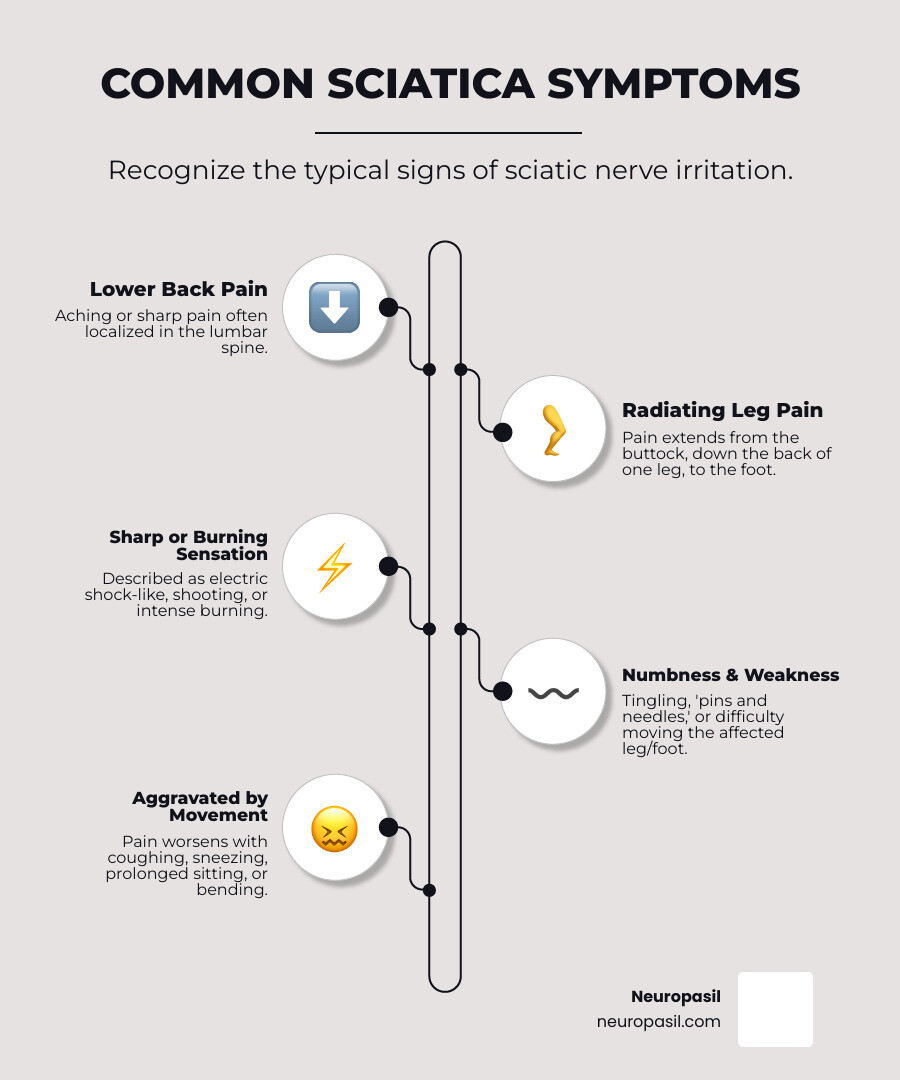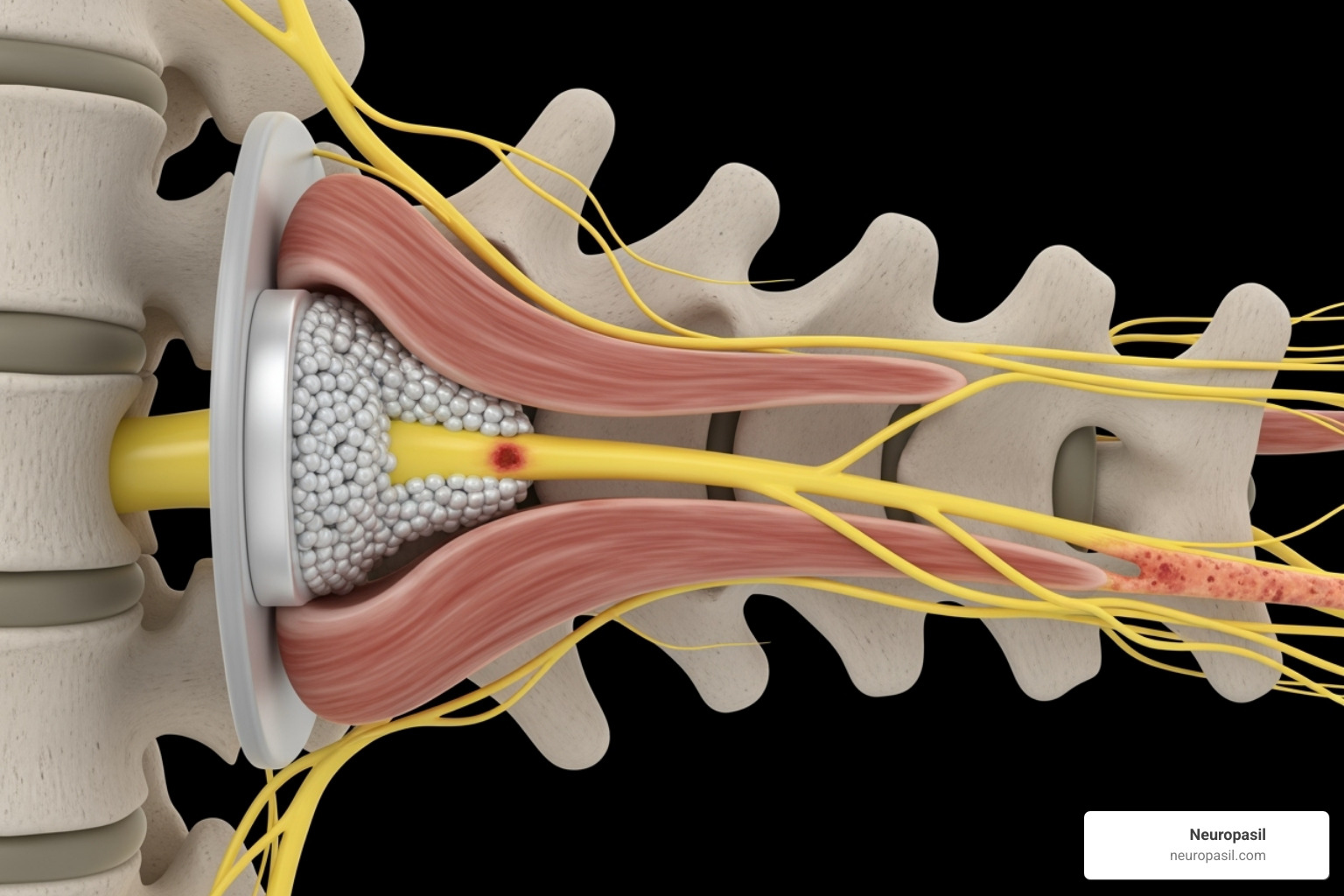Understanding Sciatica: A Common but Treatable Condition
How to relieve sciatic nerve pain is a top health search, as sciatica affects over 40% of people in the U.S. during their lifetime.
Quick Relief Methods:
- Ice therapy for 15-20 minutes to reduce inflammation
- Heat therapy after the first 48 hours to relax muscles
- Gentle stretching like knee-to-chest and piriformis stretches
- Walking and light movement to prevent stiffness
- Proper sleeping position with pillows for support
- Over-the-counter NSAIDs for pain and inflammation
Sciatica occurs when the sciatic nerve, the longest in the body, gets compressed or irritated. This causes a sharp, burning pain radiating from the lower back down the leg. It can also cause tingling, numbness, or weakness, making sitting or walking difficult.
The good news is that most people recover from sciatica within a few weeks to a few months with self-care. Medical research shows that 80% to 90% of people get better without surgery.
While the electric pain of sciatica can feel overwhelming, understanding the condition and using the right strategies can make a significant difference in managing and overcoming it.

Understanding Sciatica: What Causes the Pain?
Your sciatic nerve is the body's longest and thickest nerve, running from your lower back down to your foot. When this crucial pathway is blocked or irritated, you feel pain. Understanding what causes sciatica is the first step in learning how to relieve sciatic nerve pain effectively.

Herniated discs cause about 90% of sciatica cases. When the soft inner material of a spinal disc pushes through its tougher exterior, it can press on a nerve root. This can result from wear and tear or improper lifting.
Spinal stenosis is the narrowing of the spinal canal, which can squeeze the nerves inside. This condition is often caused by age-related changes like bone spurs from arthritis.
Piriformis syndrome occurs when the piriformis muscle, located deep in the buttock, becomes tight or spasms, compressing the sciatic nerve. It's common in people who sit for long periods or suddenly increase their activity.
Spondylolisthesis is a condition where one vertebra slips forward over the one below it, which can pinch the nerve roots.
Other causes include bone spurs, tumors (rare), trauma, and pregnancy, which can put extra pressure on the nerve.
For more detailed information, check out our guide on Sciatica Pain Symptoms. Hopkins Medicine also provides background on what is sciatica.
Common Sciatica Symptoms
Sciatica pain usually affects only one side of the body and follows the path of the sciatic nerve.
Lower back pain may be present, but the leg pain is typically much worse.
Pain radiating down one leg is the classic symptom. It often starts in the buttock and travels down the back of the thigh and calf, sometimes to the toes. The pain is described as burning, shooting, stabbing, or electric.
The sharp or burning sensation can be intense, indicating significant nerve irritation.
Numbness or weakness can make the leg feel heavy or clumsy, often accompanied by a "pins and needles" sensation, especially in the foot.
Pain with coughing or sneezing occurs because these actions increase pressure within the spine. Pain may also worsen with prolonged sitting or bending forward.
You can explore more about these symptoms on our dedicated Sciatica Symptoms page.
Red Flag Symptoms: When to Seek Emergency Care
While most sciatica improves with self-care, some symptoms require immediate medical attention. These "red flags" can signal cauda equina syndrome, a serious condition where severe nerve compression requires urgent treatment to prevent permanent damage.
Loss of bladder or bowel control is the most critical red flag. If this occurs, go to an emergency room immediately.
Numbness in the groin area (known as "saddle anesthesia") is another emergency sign. If the area that would touch a saddle becomes numb, seek immediate care.
Severe, sudden pain after an injury, such as a car accident or bad fall, requires urgent evaluation.
Weakness in both legs at the same time suggests a more serious problem than typical one-sided sciatica.
These symptoms require immediate medical attention. Early treatment can prevent permanent nerve damage.
At-Home Strategies for Immediate Sciatica Relief
When sharp, electric pain shoots down your leg, you want to know "how to relieve sciatic nerve pain right now!" Fortunately, many effective home strategies can provide significant relief.

Most people find relief through self-care within a few weeks. Surprisingly, prolonged bed rest is not the answer and can worsen sciatica by causing muscle weakness and stiffness. As Harvard Health notes, a little bit of bed rest will do you, but too much is counterproductive. Instead, focus on gentle movement and staying as active as your pain allows.
Over-the-counter NSAIDs like ibuprofen or naproxen sodium can help reduce pain and inflammation. Acetaminophen can also help with pain. Always follow the recommended dosage.
Proper posture is crucial. When sitting, use a chair with good lumbar support and keep your feet flat on the floor. When standing, distribute your weight evenly to maintain good alignment.
For more information on managing discomfort, explore our guide on Sciatica Pain.
The Hot and Cold Method
The timing of hot and cold therapy is key to its effectiveness.
Using ice packs is best for the first 48 to 72 hours of a flare-up. Ice reduces inflammation and has a numbing effect. Apply an ice pack wrapped in a towel to the painful area for 15-20 minutes at a time, several times a day.
After the initial days, switch to applying heat pads. Heat improves blood circulation, bringing healing nutrients to the area and relaxing tight muscles. Use a heating pad or take a warm bath for 15-20 minutes.
Alternating therapy between cold and heat can be effective for persistent pain. Listen to your body to determine which temperature feels most soothing.
Finding a Comfortable Position
Finding the right position can significantly improve comfort and sleep quality.
Sleeping on your side with a pillow between your knees helps align your spine, hips, and pelvis, reducing pressure on the sciatic nerve.
If you sleep on your back, try lying on your back with pillows under your knees to maintain the natural curve of your lower back. The fetal position can also help by opening space between your vertebrae.
Avoid sleeping on your stomach, as it can flatten your spine's natural curve and strain your neck and lower back, potentially worsening your pain.
A medium-firm mattress generally provides the best balance of support and comfort, preventing spinal misalignment without creating painful pressure points.
The Role of Exercise and Stretching in Relieving Sciatic Nerve Pain
While movement might seem counterintuitive when you're in pain, gentle exercise and targeted stretching are key for long-term relief. Regular movement improves flexibility, strengthens core muscles that support the spine, and reduces pressure on the sciatic nerve.

Studies show 80-90% of people with sciatica improve, and stretching is a major factor. As Harvard Health Publishing explains, stretching is essential for managing pain. Your sciatic nerve is surrounded by muscles that, when flexible and strong, create space and support. Just 10-15 minutes of gentle movement daily can make a significant difference.
5 Gentle Stretches for How to Relieve Sciatic Nerve Pain
Move slowly and listen to your body. A gentle stretch should feel like relief, not sharp pain. Hold each stretch for 15-30 seconds without bouncing.
1. Knee-to-Chest Stretch: Lie on your back with knees bent and slowly pull one knee toward your chest. Hold to release tension in your lower back.
2. Seated Spinal Twist: Sit with legs extended, bend one knee, and gently twist your torso toward the bent knee. This helps mobilize your spine.
3. Piriformis Stretch (Figure-4): Lie on your back and cross one ankle over the opposite knee. Gently pull the thigh toward your chest to feel a stretch deep in your buttock.
4. Standing Hamstring Stretch: Place your heel on a low chair or step with your leg straight. Gently lean forward from your hips to stretch the back of your thigh.
5. Cat-Cow Pose: On your hands and knees, alternate between arching and rounding your back. This movement gently mobilizes the entire spine.
Low-Impact Exercises to Stay Active
Beyond stretching, low-impact exercises are crucial for lasting relief.
Walking: A gentle 10-15 minute walk keeps your spine mobile and strengthens supporting muscles. Start small and gradually increase your distance.
Swimming and water aerobics: The water's buoyancy supports your body, taking pressure off your spine. The backstroke is particularly beneficial.
Stationary cycling: This provides a cardiovascular workout while keeping your spine supported in a comfortable, seated position.
Yoga and Tai Chi: These practices combine movement, stretching, and mindfulness. Yoga can target specific tight muscles, while Tai Chi's slow movements improve balance and core stability.
The golden rule is to stay within your comfort zone. If you're unsure where to start, a physical therapist can create a personalized plan.
When and How to Seek Professional Help for How to Relieve Sciatic Nerve Pain
If home remedies don't provide relief after a few weeks, it's time to seek professional help. A healthcare provider can offer advanced treatments when your sciatica interferes with daily life. Our guide on Sciatic Nerve Pain can help you determine when to seek professional care. Modern medical approaches are highly effective, as shown in research from the NCBI on sciatica diagnosis and treatment.
Physical therapy is a cornerstone of professional treatment. A physical therapist creates a personalized program to strengthen your core, improve mobility, and teach you proper body mechanics.
Prescription medications may be used when OTC options are insufficient. Epidural steroid injections deliver powerful anti-inflammatory medicine directly to the irritated nerve, providing relief that can last for months.
Other effective treatments include chiropractic care for spinal adjustments, acupuncture to interrupt pain signals, and massage therapy to loosen tight muscles.
Medical Treatments: What Your Doctor May Recommend for How to Relieve Sciatic Nerve Pain
Your doctor has several tools to address your specific pain.
Muscle relaxants can help if muscle spasms are a significant issue. Anti-seizure medications like gabapentin are effective at calming overactive nerve signals that cause sharp, shooting pain.
Corticosteroid injections deliver potent anti-inflammatory medication directly to the pain source, providing relief that can last for weeks or months.
A physical therapy referral is highly valuable because, as experts note, there is no one-size-fits-all approach to sciatica. A professional can tailor a plan to your specific needs.
Is Surgery Necessary for Sciatica?
Reassuringly, surgery is rarely needed for sciatica. About 80-90% of people recover without it. Surgery is typically considered only after several months of conservative treatments have failed to provide relief.
Other indications for surgery include severe weakness in the leg or foot, suggesting ongoing nerve damage, or loss of bowel or bladder control, which is a medical emergency requiring immediate surgical intervention.
The most common procedures are microdiscectomy (removing the part of a herniated disc pressing on the nerve) and laminectomy (creating more space in the spinal canal). When appropriate, surgery has a high success rate, with about 90% of people experiencing significant relief.
An honest conversation with your medical team will determine the right path for you. Surgery isn't a failure of other treatments; sometimes, it's simply the most effective tool for the job.
Frequently Asked Questions about Sciatica Relief
It's natural to have questions when dealing with sciatica. Here are answers to some common concerns about how to relieve sciatic nerve pain.
How long does sciatica take to go away?
Most cases of acute sciatica improve within 4-6 weeks with self-care and staying active. If pain persists for more than 12 weeks, it's considered chronic sciatica. Even chronic cases can respond well to consistent treatment, but it's important to seek help early (before six months) for the best outcome.
Can sciatica be permanently cured?
Yes, since sciatica is a symptom, addressing the root cause often leads to a permanent cure. An impressive 80-90% of people recover without surgery, usually through self-care, exercise, and physical therapy. Prevention is key to avoiding recurrence. Maintaining good posture, strengthening your core, and using proper lifting techniques can help keep sciatica from returning.
What should you not do when you have sciatica?
Knowing what to avoid is as important as knowing what to do.
Avoid prolonged sitting: Get up and move every 30 minutes to prevent stiffness and pressure on the nerve.
Don't lift heavy objects: This puts significant strain on your lower back. When you must lift, bend your knees and keep your back straight, avoiding any twisting motions.
Avoid high-impact exercise: During a flare-up, stick to gentle activities like walking or swimming instead of running or jumping.
Don't ignore severe symptoms: Loss of bladder or bowel control, numbness in the groin, or severe weakness in both legs are medical emergencies that require immediate attention.
Conclusion: Your Path to a Pain-Free Life

If you're struggling with sciatica, there is reason for optimism. Understanding how to relieve sciatic nerve pain is the first step, and relief is achievable for most people. 80-90% of individuals with sciatica recover without surgery.
Your recovery toolkit includes immediate relief strategies like ice and heat therapy, gentle movement, and proper sleeping positions. These are proven methods to start your healing. Gentle stretches and low-impact exercises provide current relief and build the strength and flexibility to prevent future flare-ups.
Consistency is your secret weapon. Small, daily actions lead to significant improvements. When self-care isn't enough, professional help from a physical therapist or doctor can provide the support you need.
Lifestyle changes are crucial for prevention. Simple adjustments like taking breaks from sitting, using proper lifting form, and maintaining a healthy weight can dramatically reduce your risk of future episodes.
At Neuropasil, we are committed to providing reliable, research-backed information to empower you on your recovery journey. Your path to a pain-free life is about reclaiming your freedom to move and enjoy life without pain.
For continued support and detailed guidance, learn more about managing Sciatic Nerve Pain on our comprehensive resource page. Your journey to lasting relief starts now.














